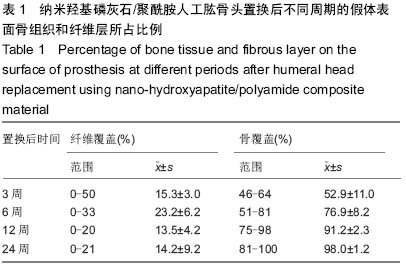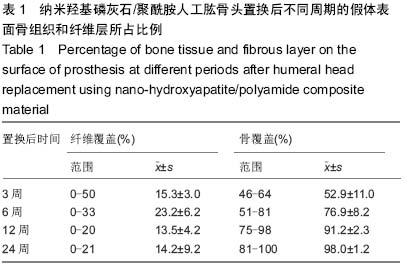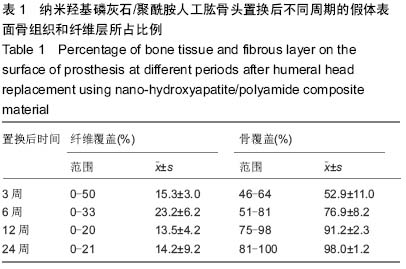中国组织工程研究 ›› 2015, Vol. 19 ›› Issue (30): 4769-4773.doi: 10.3969/j.issn.2095-4344.2015.30.003
• 纳米生物材料 nanobiomaterials • 上一篇 下一篇
纳米羟基磷灰石/聚酰胺材料的体内成骨能力
徐显春1,王 治2,侯铁奇3
- 1宜宾市第一人民医院骨一科,四川省宜宾市 644000; 2泸州医学院附属医院骨与关节外科,四川省泸州市 646000; 3暨南大学医学院,广东省广州市 510632
In vivo osteogenic capability of nano-hydroxyapatite/polyamide composite material
Xu Xian-chun1, Wang Zhi2, Hou Tie-qi3
- 1First Department of Orthopedics, First People’s Hospital of Yibin, Yibin 644000, Sichuan Province, China; 2Department of Bone and Joint Surgery, Affiliated Hospital of Sichuan Medical University, Luzhou 646000, Sichuan Province, China; Medical School of Jinan University, Guangzhou 510632, Guangdong Province, China
摘要:
背景:作为骨修复重建材料,纳米羟基磷灰石具有良好生物相容性及骨传导性,但临床上中单一使用纳米羟基磷灰石尚存在许多不足。
目的:观察纳米羟基磷灰石/聚酰胺材料的体内成骨能力。
方法:取24只新西兰大白兔,进行纳米羟基磷灰石/聚酰胺人工肱骨头置换,分别于置换后3,6,12,24周,进行X射线观察、组织学观察。
结果与结论:①X射线观察:不同时间点材料上端皮质均未出现骨皮质变薄、异位骨化等发生,纳米羟基磷灰石/聚酰胺材料无碎裂迹象,材料四周皮质均可见模糊界面,密度随着时间的增加而增加。②组织学观察:置换后3周,可见大量细胞,包括间充质细胞、单核巨噬细胞等;置换后6周,仍可见界膜内的大量纤维组织、成纤维细胞、单核巨噬细胞,而软骨细胞和成骨细胞分布较少;置换后12周,大范围原始骨小梁开始形成且多呈扁平状,排列整齐有序;置换后24周,组织界膜被骨细胞充斥,骨小梁表面的细胞较规则,骨组织原始细胞开始转变为板层状骨。说明纳米羟基磷灰石/聚酰胺材料具有良好的成骨能力。
;骨生物材料; 口腔生物材料; 纳米材料; 缓释材料; 材料相容性;组织工程
中图分类号:


